JEEP CHEROKEE 2014 KL / 5.G Manual PDF
Manufacturer: JEEP, Model Year: 2014, Model line: CHEROKEE, Model: JEEP CHEROKEE 2014 KL / 5.GPages: 690, PDF Size: 4.74 MB
Page 71 of 690

WARNING!
•No objects should be placed over or near the air bag
on the instrument panel, because any such objects
could cause harm if the vehicle is in a collision
severe enough to cause the air bag to inflate.
•Do not put anything on or around the air bag covers
or attempt to open them manually. You may damage
the air bags and you could be injured because the air
bags may no longer be functional. The protective
covers for the air bag cushions are designed to open
only when the air bags are inflating.
• Do not drill, cut or tamper with the knee bolster in
any way.
•
Do not mount any accessories to the knee bolster
such as alarm lights, stereos, citizen band radios, etc.
Supplemental Seat-Mounted Side Air Bags (SAB)
Supplemental Seat-Mounted Side Air Bags (SAB) may
provide enhanced protection to help protect an occupant
during a side impact. The SAB is marked with an air bag
label sewn into the outboard side of the seats.
Supplemental Seat-Mounted Side Air Bag Label
2
THINGS TO KNOW BEFORE STARTING YOUR VEHICLE 69
Page 72 of 690
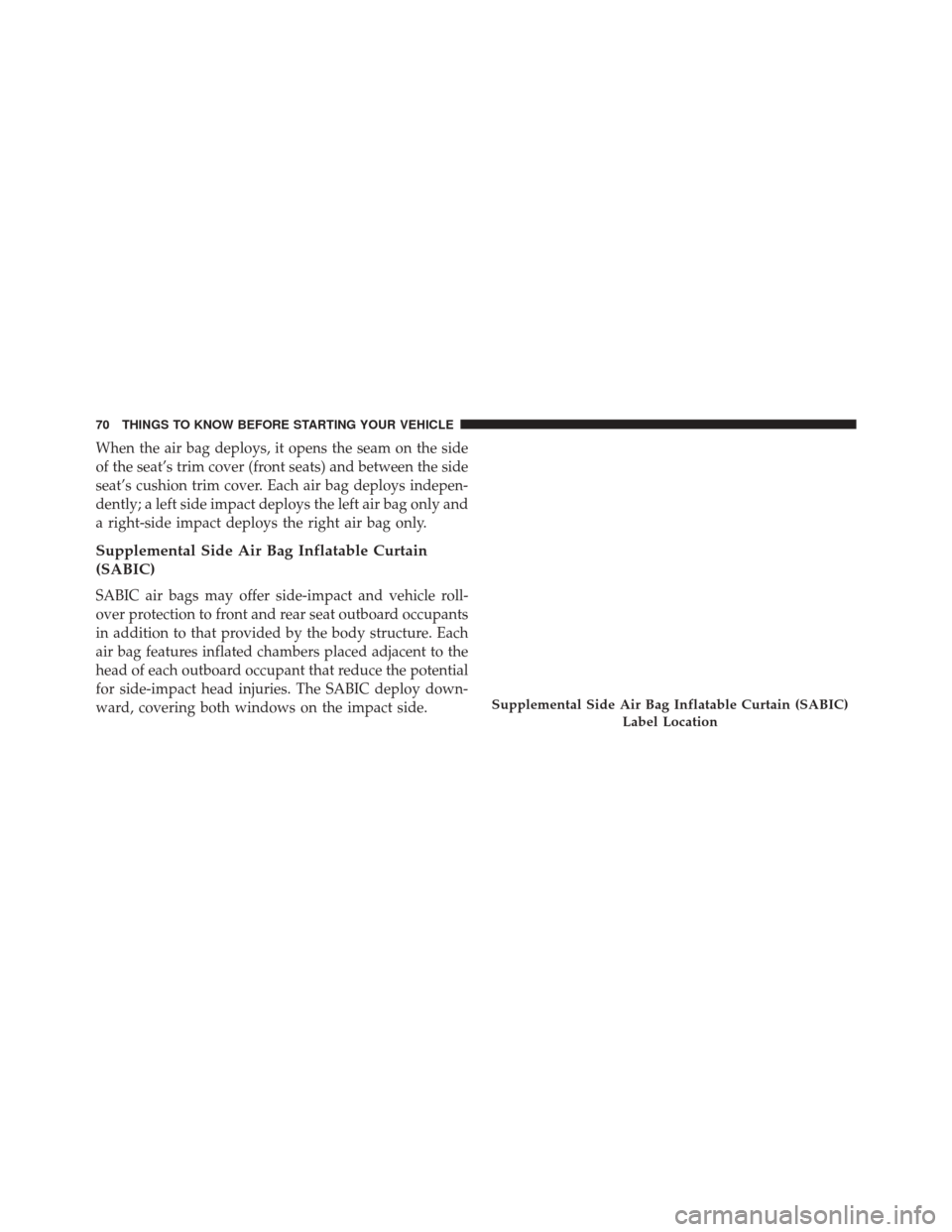
When the air bag deploys, it opens the seam on the side
of the seat’s trim cover (front seats) and between the side
seat’s cushion trim cover. Each air bag deploys indepen-
dently; a left side impact deploys the left air bag only and
a right-side impact deploys the right air bag only.
Supplemental Side Air Bag Inflatable Curtain
(SABIC)
SABIC air bags may offer side-impact and vehicle roll-
over protection to front and rear seat outboard occupants
in addition to that provided by the body structure. Each
air bag features inflated chambers placed adjacent to the
head of each outboard occupant that reduce the potential
for side-impact head injuries. The SABIC deploy down-
ward, covering both windows on the impact side.
Supplemental Side Air Bag Inflatable Curtain (SABIC)Label Location
70 THINGS TO KNOW BEFORE STARTING YOUR VEHICLE
Page 73 of 690
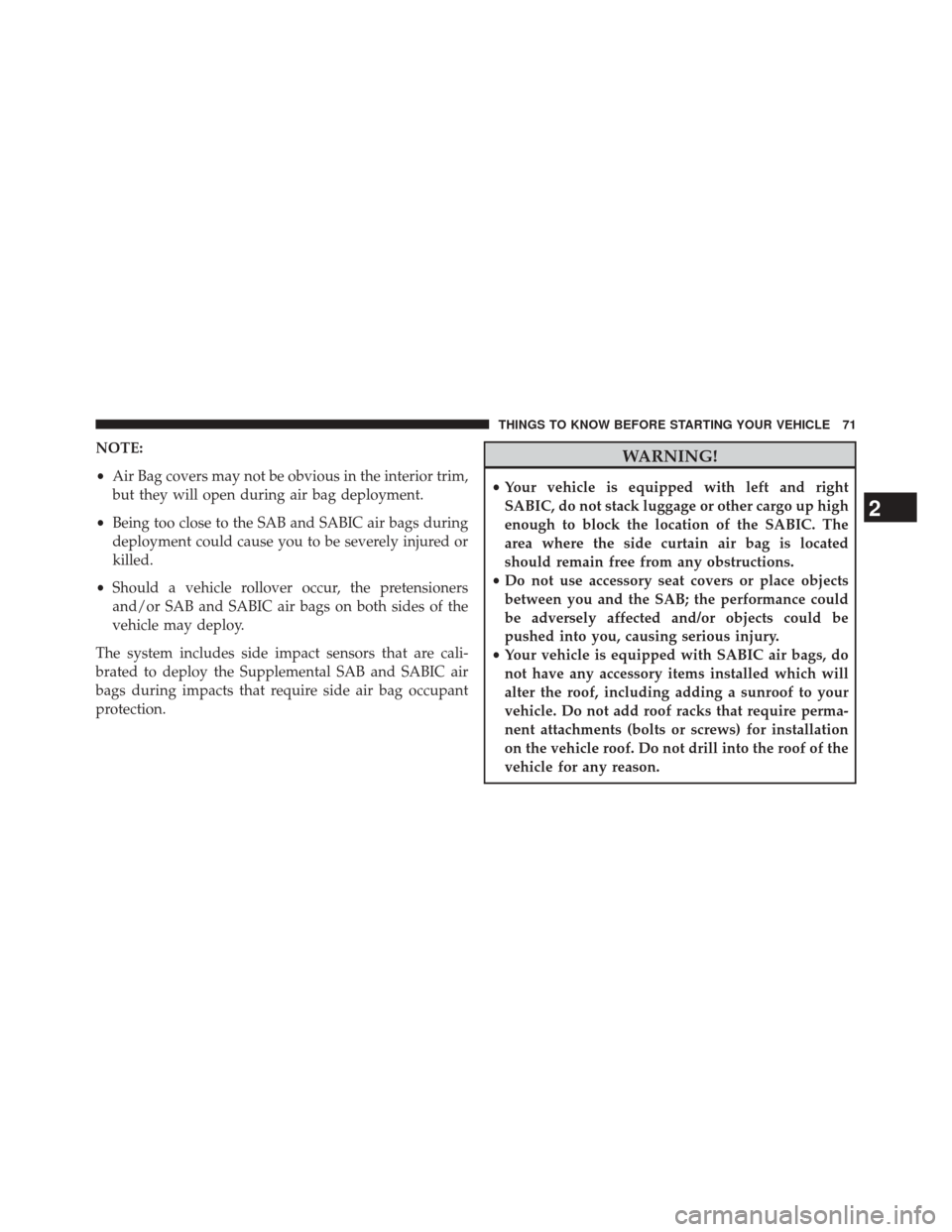
NOTE:
•Air Bag covers may not be obvious in the interior trim,
but they will open during air bag deployment.
• Being too close to the SAB and SABIC air bags during
deployment could cause you to be severely injured or
killed.
• Should a vehicle rollover occur, the pretensioners
and/or SAB and SABIC air bags on both sides of the
vehicle may deploy.
The system includes side impact sensors that are cali-
brated to deploy the Supplemental SAB and SABIC air
bags during impacts that require side air bag occupant
protection.WARNING!
• Your vehicle is equipped with left and right
SABIC, do not stack luggage or other cargo up high
enough to block the location of the SABIC. The
area where the side curtain air bag is located
should remain free from any obstructions.
• Do not use accessory seat covers or place objects
between you and the SAB; the performance could
be adversely affected and/or objects could be
pushed into you, causing serious injury.
• Your vehicle is equipped with SABIC air bags, do
not have any accessory items installed which will
alter the roof, including adding a sunroof to your
vehicle. Do not add roof racks that require perma-
nent attachments (bolts or screws) for installation
on the vehicle roof. Do not drill into the roof of the
vehicle for any reason.
2
THINGS TO KNOW BEFORE STARTING YOUR VEHICLE 71
Page 74 of 690
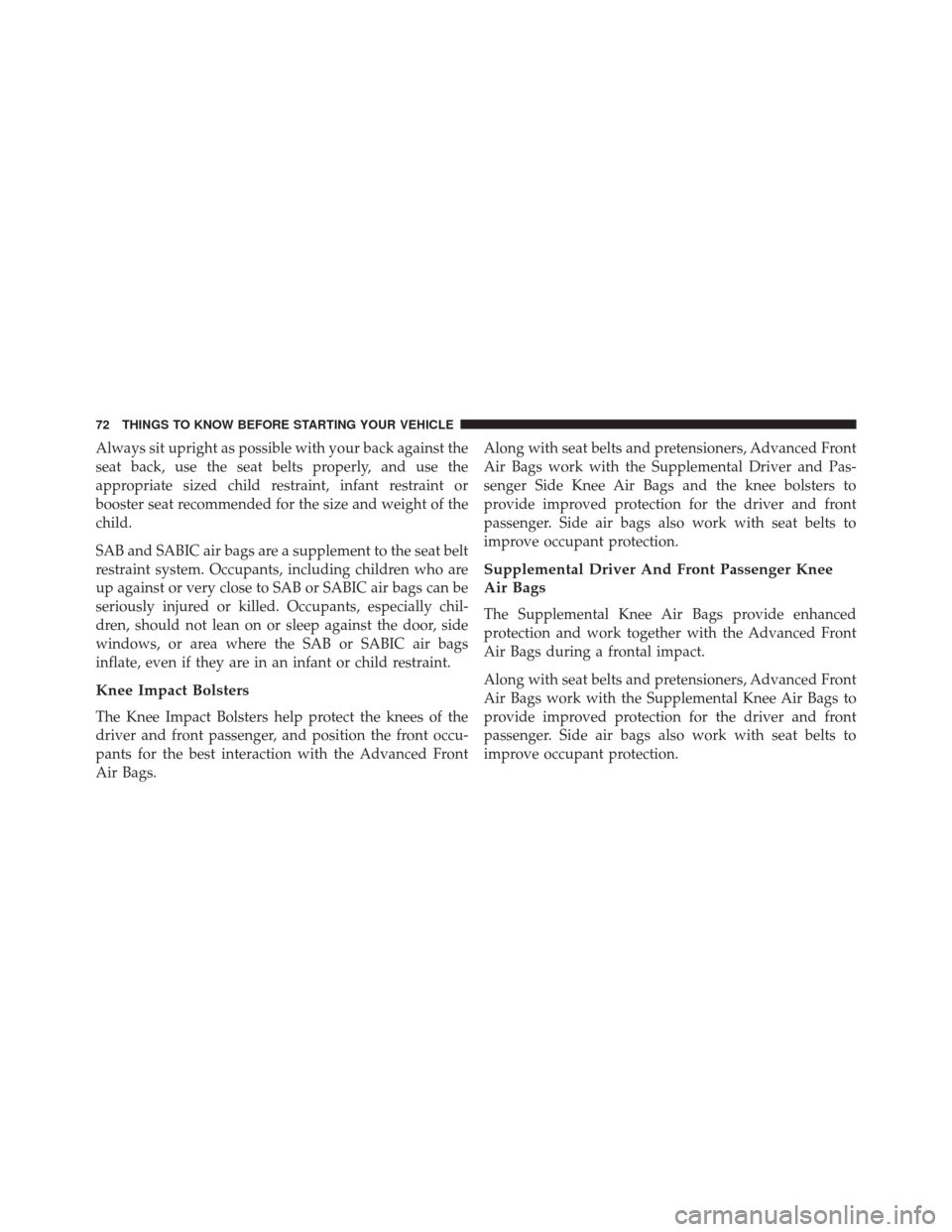
Always sit upright as possible with your back against the
seat back, use the seat belts properly, and use the
appropriate sized child restraint, infant restraint or
booster seat recommended for the size and weight of the
child.
SAB and SABIC air bags are a supplement to the seat belt
restraint system. Occupants, including children who are
up against or very close to SAB or SABIC air bags can be
seriously injured or killed. Occupants, especially chil-
dren, should not lean on or sleep against the door, side
windows, or area where the SAB or SABIC air bags
inflate, even if they are in an infant or child restraint.
Knee Impact Bolsters
The Knee Impact Bolsters help protect the knees of the
driver and front passenger, and position the front occu-
pants for the best interaction with the Advanced Front
Air Bags.Along with seat belts and pretensioners, Advanced Front
Air Bags work with the Supplemental Driver and Pas-
senger Side Knee Air Bags and the knee bolsters to
provide improved protection for the driver and front
passenger. Side air bags also work with seat belts to
improve occupant protection.
Supplemental Driver And Front Passenger Knee
Air Bags
The Supplemental Knee Air Bags provide enhanced
protection and work together with the Advanced Front
Air Bags during a frontal impact.
Along with seat belts and pretensioners, Advanced Front
Air Bags work with the Supplemental Knee Air Bags to
provide improved protection for the driver and front
passenger. Side air bags also work with seat belts to
improve occupant protection.
72 THINGS TO KNOW BEFORE STARTING YOUR VEHICLE
Page 75 of 690
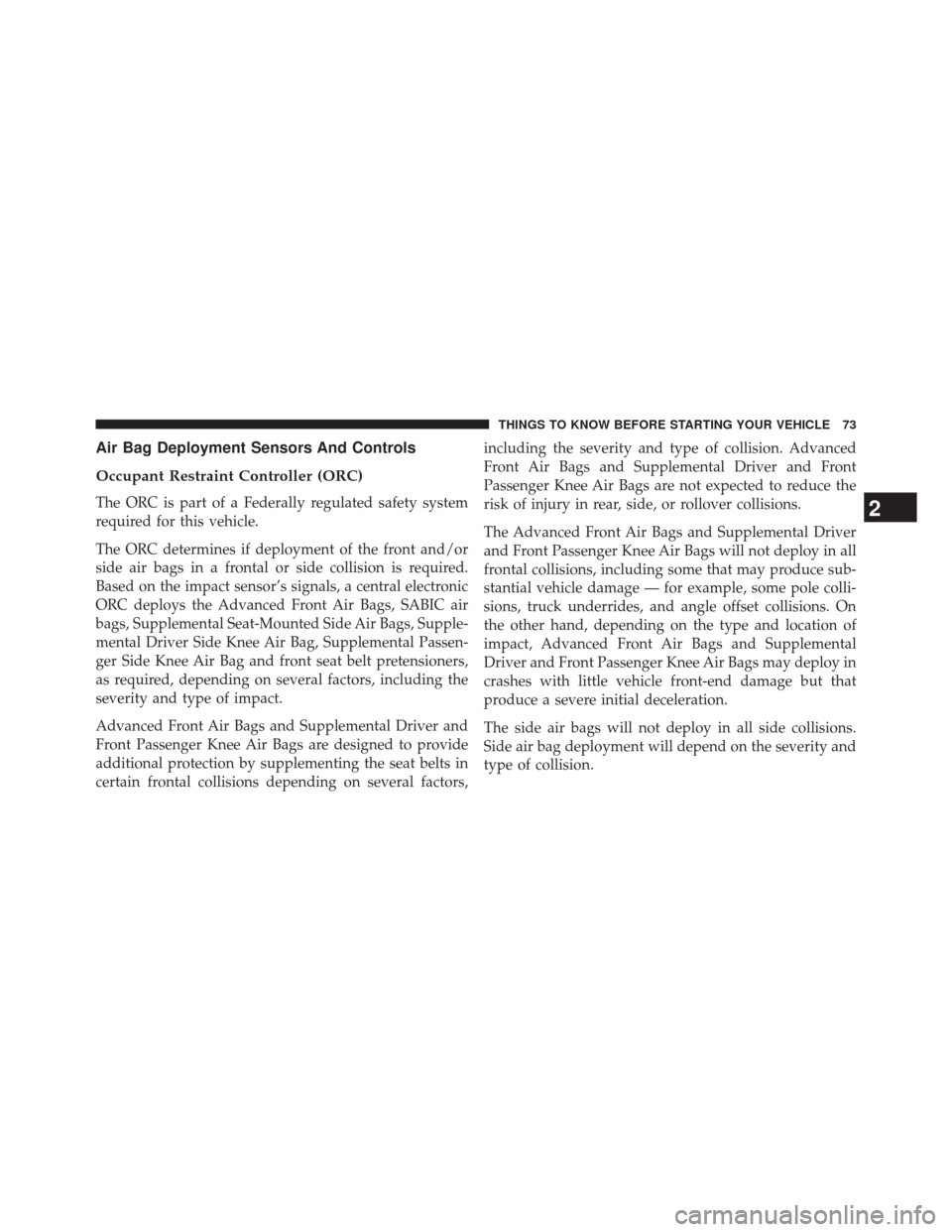
Air Bag Deployment Sensors And Controls
Occupant Restraint Controller (ORC)
The ORC is part of a Federally regulated safety system
required for this vehicle.
The ORC determines if deployment of the front and/or
side air bags in a frontal or side collision is required.
Based on the impact sensor’s signals, a central electronic
ORC deploys the Advanced Front Air Bags, SABIC air
bags, Supplemental Seat-Mounted Side Air Bags, Supple-
mental Driver Side Knee Air Bag, Supplemental Passen-
ger Side Knee Air Bag and front seat belt pretensioners,
as required, depending on several factors, including the
severity and type of impact.
Advanced Front Air Bags and Supplemental Driver and
Front Passenger Knee Air Bags are designed to provide
additional protection by supplementing the seat belts in
certain frontal collisions depending on several factors,including the severity and type of collision. Advanced
Front Air Bags and Supplemental Driver and Front
Passenger Knee Air Bags are not expected to reduce the
risk of injury in rear, side, or rollover collisions.
The Advanced Front Air Bags and Supplemental Driver
and Front Passenger Knee Air Bags will not deploy in all
frontal collisions, including some that may produce sub-
stantial vehicle damage — for example, some pole colli-
sions, truck underrides, and angle offset collisions. On
the other hand, depending on the type and location of
impact, Advanced Front Air Bags and Supplemental
Driver and Front Passenger Knee Air Bags may deploy in
crashes with little vehicle front-end damage but that
produce a severe initial deceleration.
The side air bags will not deploy in all side collisions.
Side air bag deployment will depend on the severity and
type of collision.2
THINGS TO KNOW BEFORE STARTING YOUR VEHICLE 73
Page 76 of 690
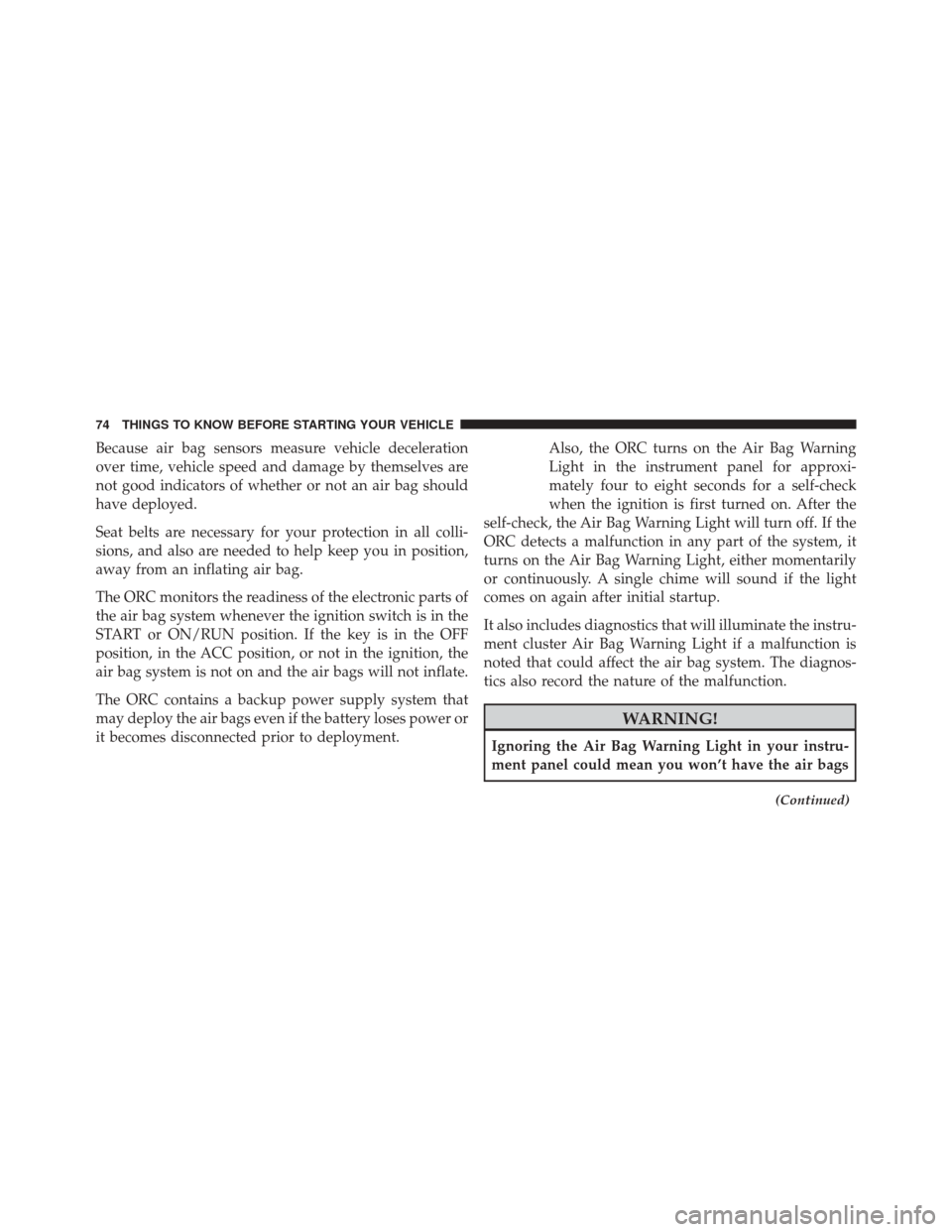
Because air bag sensors measure vehicle deceleration
over time, vehicle speed and damage by themselves are
not good indicators of whether or not an air bag should
have deployed.
Seat belts are necessary for your protection in all colli-
sions, and also are needed to help keep you in position,
away from an inflating air bag.
The ORC monitors the readiness of the electronic parts of
the air bag system whenever the ignition switch is in the
START or ON/RUN position. If the key is in the OFF
position, in the ACC position, or not in the ignition, the
air bag system is not on and the air bags will not inflate.
The ORC contains a backup power supply system that
may deploy the air bags even if the battery loses power or
it becomes disconnected prior to deployment.Also, the ORC turns on the Air Bag Warning
Light in the instrument panel for approxi-
mately four to eight seconds for a self-check
when the ignition is first turned on. After the
self-check, the Air Bag Warning Light will turn off. If the
ORC detects a malfunction in any part of the system, it
turns on the Air Bag Warning Light, either momentarily
or continuously. A single chime will sound if the light
comes on again after initial startup.
It also includes diagnostics that will illuminate the instru-
ment cluster Air Bag Warning Light if a malfunction is
noted that could affect the air bag system. The diagnos-
tics also record the nature of the malfunction.
WARNING!
Ignoring the Air Bag Warning Light in your instru-
ment panel could mean you won’t have the air bags
(Continued)
74 THINGS TO KNOW BEFORE STARTING YOUR VEHICLE
Page 77 of 690
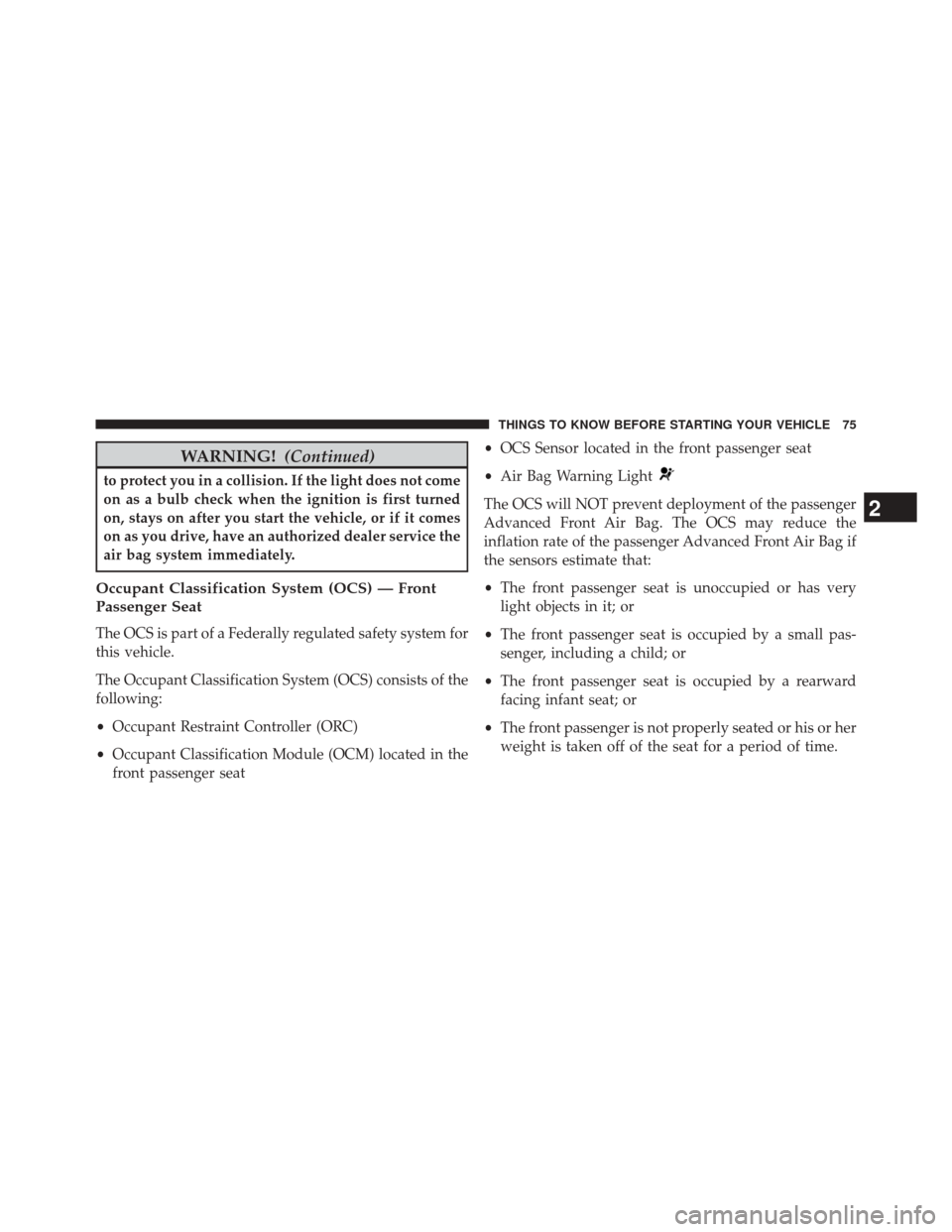
WARNING!(Continued)
to protect you in a collision. If the light does not come
on as a bulb check when the ignition is first turned
on, stays on after you start the vehicle, or if it comes
on as you drive, have an authorized dealer service the
air bag system immediately.
Occupant Classification System (OCS) — Front
Passenger Seat
The OCS is part of a Federally regulated safety system for
this vehicle.
The Occupant Classification System (OCS) consists of the
following:
•Occupant Restraint Controller (ORC)
• Occupant Classification Module (OCM) located in the
front passenger seat •
OCS Sensor located in the front passenger seat
• Air Bag Warning Light
The OCS will NOT prevent deployment of the passenger
Advanced Front Air Bag. The OCS may reduce the
inflation rate of the passenger Advanced Front Air Bag if
the sensors estimate that:
•The front passenger seat is unoccupied or has very
light objects in it; or
• The front passenger seat is occupied by a small pas-
senger, including a child; or
• The front passenger seat is occupied by a rearward
facing infant seat; or
• The front passenger is not properly seated or his or her
weight is taken off of the seat for a period of time.2
THINGS TO KNOW BEFORE STARTING YOUR VEHICLE 75
Page 78 of 690
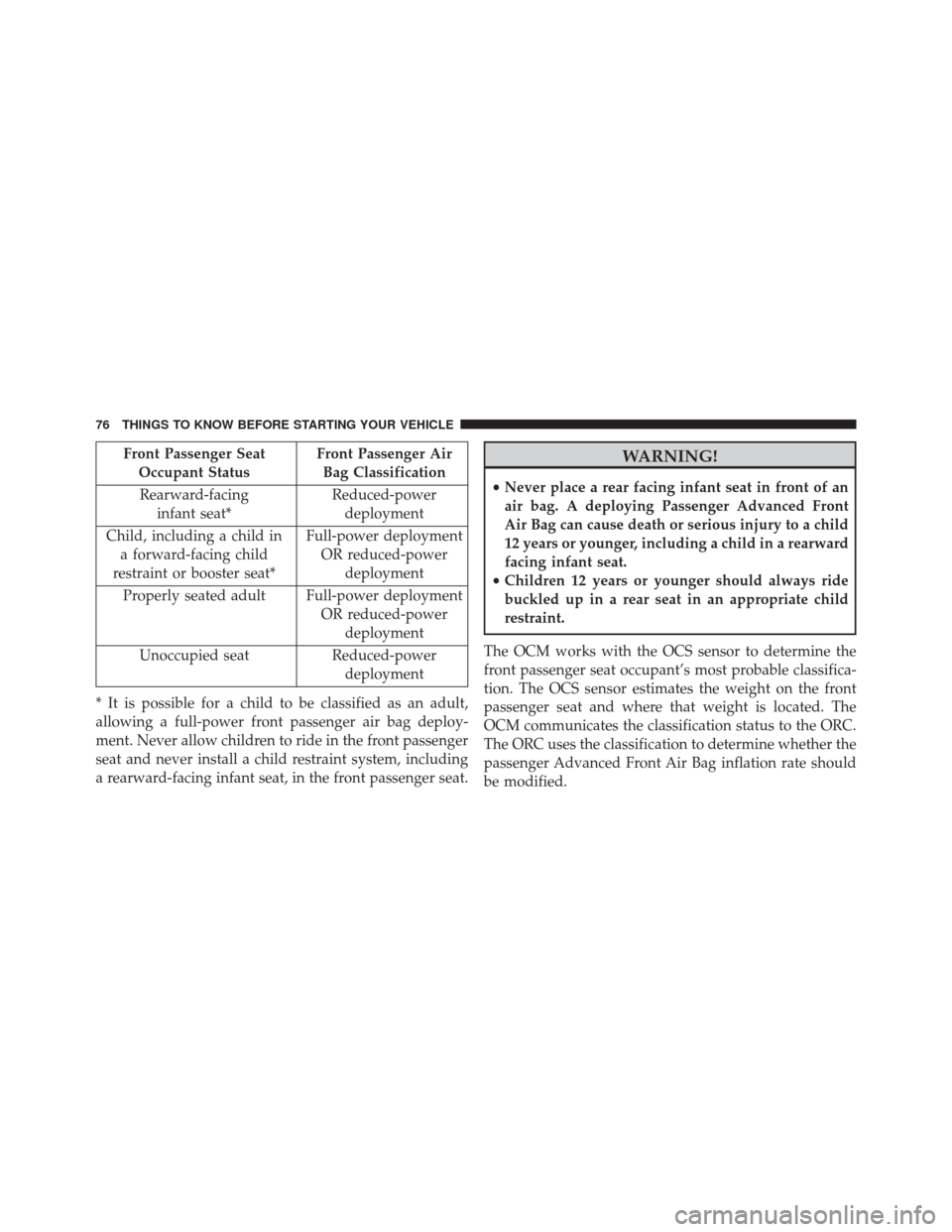
Front Passenger SeatOccupant Status Front Passenger Air
Bag Classification
Rearward-facing infant seat* Reduced-power
deployment
Child, including a child in a forward-facing child
restraint or booster seat* Full-power deployment
OR reduced-power deployment
Properly seated adult Full-power deployment OR reduced-powerdeployment
Unoccupied seat Reduced-power deployment
* It is possible for a child to be classified as an adult,
allowing a full-power front passenger air bag deploy-
ment. Never allow children to ride in the front passenger
seat and never install a child restraint system, including
a rearward-facing infant seat, in the front passenger seat.WARNING!
• Never place a rear facing infant seat in front of an
air bag. A deploying Passenger Advanced Front
Air Bag can cause death or serious injury to a child
12 years or younger, including a child in a rearward
facing infant seat.
• Children 12 years or younger should always ride
buckled up in a rear seat in an appropriate child
restraint.
The OCM works with the OCS sensor to determine the
front passenger seat occupant’s most probable classifica-
tion. The OCS sensor estimates the weight on the front
passenger seat and where that weight is located. The
OCM communicates the classification status to the ORC.
The ORC uses the classification to determine whether the
passenger Advanced Front Air Bag inflation rate should
be modified.
76 THINGS TO KNOW BEFORE STARTING YOUR VEHICLE
Page 79 of 690
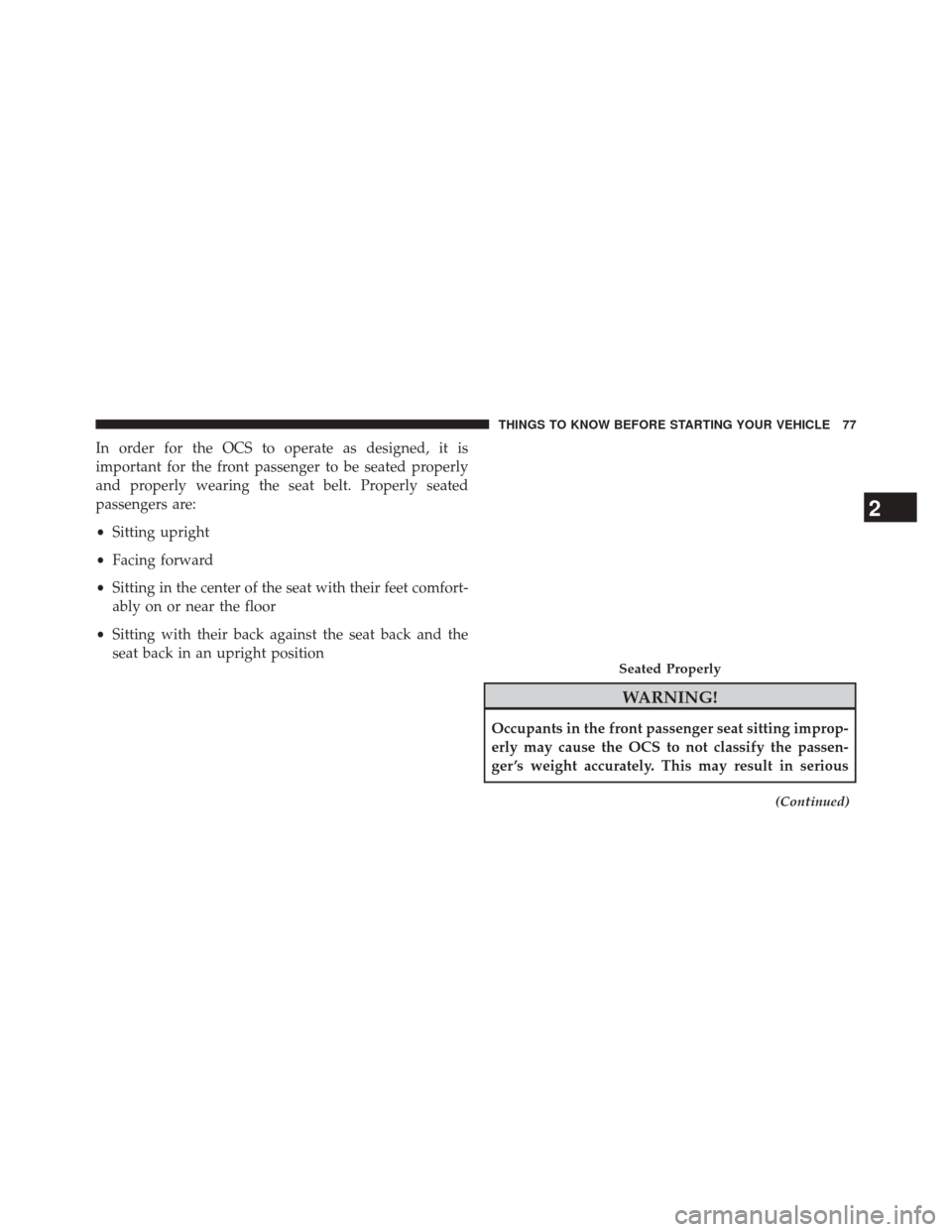
In order for the OCS to operate as designed, it is
important for the front passenger to be seated properly
and properly wearing the seat belt. Properly seated
passengers are:
•Sitting upright
• Facing forward
• Sitting in the center of the seat with their feet comfort-
ably on or near the floor
• Sitting with their back against the seat back and the
seat back in an upright position
WARNING!
Occupants in the front passenger seat sitting improp-
erly may cause the OCS to not classify the passen-
ger ’s weight accurately. This may result in serious
(Continued)
Seated Properly
2
THINGS TO KNOW BEFORE STARTING YOUR VEHICLE 77
Page 80 of 690
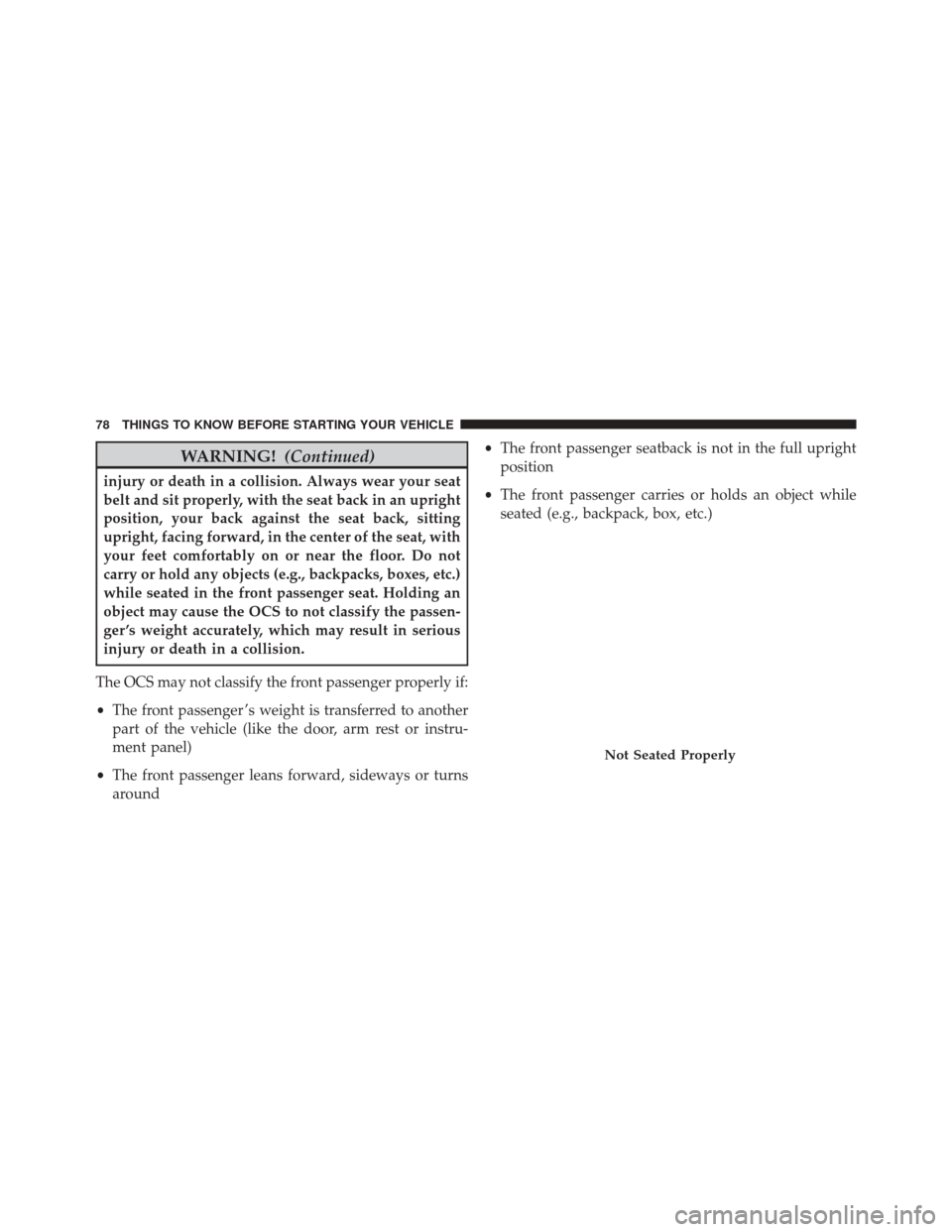
WARNING!(Continued)
injury or death in a collision. Always wear your seat
belt and sit properly, with the seat back in an upright
position, your back against the seat back, sitting
upright, facing forward, in the center of the seat, with
your feet comfortably on or near the floor. Do not
carry or hold any objects (e.g., backpacks, boxes, etc.)
while seated in the front passenger seat. Holding an
object may cause the OCS to not classify the passen-
ger ’s weight accurately, which may result in serious
injury or death in a collision.
The OCS may not classify the front passenger properly if:
• The front passenger ’s weight is transferred to another
part of the vehicle (like the door, arm rest or instru-
ment panel)
• The front passenger leans forward, sideways or turns
around •
The front passenger seatback is not in the full upright
position
• The front passenger carries or holds an object while
seated (e.g., backpack, box, etc.)
Not Seated Properly
78 THINGS TO KNOW BEFORE STARTING YOUR VEHICLE